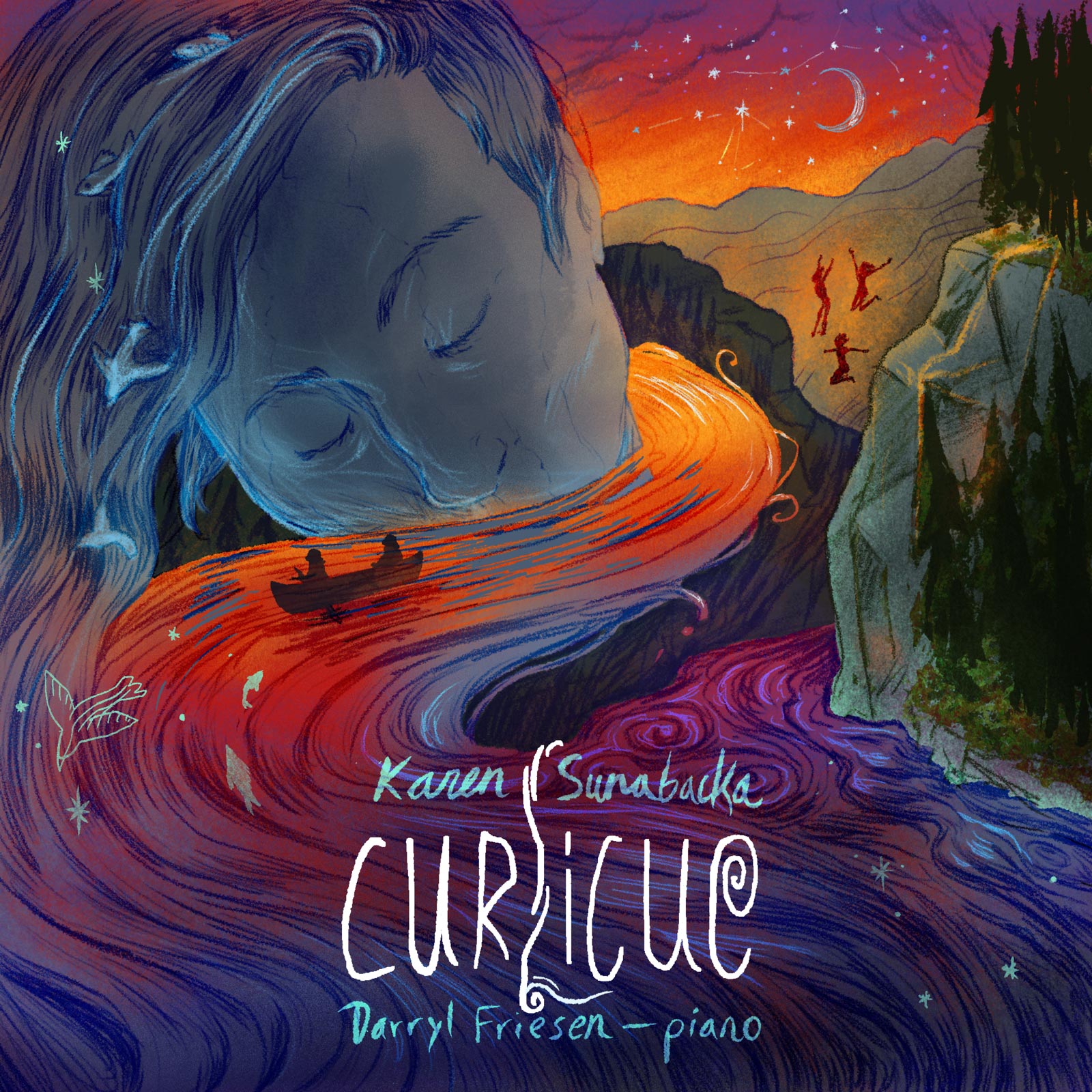Curlicue
Karen Sunabacka composer
Darryl Friesen piano
Wide skies, whistling winds, and a love for the great outdoors take center stage on Karen Sunabacka’s CURLICUE, a collection of eight works for solo piano performed by Darryl Friesen. Each piece tells a story of Sunabacka’s wilderness adventures, from the titular Curlicue’s explorations of the twists, turns, and curls of a river, to Falling in the Water’s conjuration of girls jumping into water and sheets of rain pummeling tents, to Lost’s encapsulation of the fear and dread of losing one’s way. Friesen’s crisp performance brings each piece to life, transporting listeners to the Canadian woodlands and prairies for an adventure all their own.
Listen
Stream/Buy
Choose your platform
Track Listing & Credits
| # | Title | Composer | Performer | |
|---|---|---|---|---|
| 01 | Curlicue | Karen Sunabacka | Darryl Friesen, piano | 12:10 |
| 02 | Hiding | Karen Sunabacka | Darryl Friesen, piano | 3:59 |
| 03 | …our inner lives were entwined…embroidered with the same pattern | Karen Sunabacka | Darryl Friesen, piano | 4:51 |
| 04 | Falling in the Water | Karen Sunabacka | Darryl Friesen, piano; the recorded voices of the 2004 Manitoba Pioneer Camp Girls Leaders-in-Training program, electronics | 10:23 |
| 05 | A Canoe on a Lake | Karen Sunabacka | Darryl Friesen, piano | 0:51 |
| 06 | Falling Water | Karen Sunabacka | Darryl Friesen, piano | 10:53 |
| 07 | Lost | Karen Sunabacka | Darryl Friesen, piano | 2:48 |
| 08 | Spider Solitaire | Karen Sunabacka | Darryl Friesen, piano | 18:09 |
Recorded November 9-10, 2021 at Revolution Recording in Toronto, Canada
Session Producer Earl McCluskie
Session Engineer Luke Schindler
Falling in the Water
Karen Sunabacka recorded the voices and the sounds of nature (water, wind, thunder…etc) in June & July 2004 in Northwestern Ontario. Voices are the 2004 Manitoba Pioneer Camp, Girls Camp, Leaders-in-Training (six 16-year-old girls) with their two leaders (Karen Sunabacka was one of the leaders). They were recorded and their voices used with permission.
Executive Producer Bob Lord
A&R Director Brandon MacNeil
VP of Production Jan Košulič
Audio Director Lucas Paquette
VP, Design & Marketing Brett Picknell
Art Director Ryan Harrison
Design Edward A. Fleming
Publicity Patrick Niland, Aidan Curran
Artist Information

Karen Sunabacka
Composer Karen Sunabacka often finds inspiration from puzzles, stories, and her Métis and mixed European heritage. She has deep roots in the Red River Area (what is now known as Manitoba, Canada) and feels a strong connection to the Métis, Scottish, Swedish and Finnish cultures. This mix of cultural connections sometimes creates conflicts and new perspectives which she finds both interesting and challenging. Her music reflects this cultural mix through the exploration of the sounds and stories of the Canadian prairies.

Darryl Friesen
Darryl Friesen has given acclaimed performances as a soloist and collaborative artist across Canada, the United States, Europe, China, and Brazil. He has performed as soloist with the Winnipeg Symphony Orchestra, and as a collaborator and recitalist with many distinguished artists, including Elliot Madore, Andrew Wan, Allen Harrington, Catherine Daniel, Millicent Scarlett, Valdine Anderson, the Adaskin String Trio, and the Martha Graham Dance Company. Friesen’s debut album, CURLICUE: The Solo Piano Works of Karen Sunabacka, was released by Ravello Records in September 2022.
Notes

Curlicue_Notes-1
Karen Sunabacka and Darryl Friesen
The solo piano works recorded here were inspired by my love of storytelling and deep connections to the wide skies and whistling winds of my prairie home. Also explored is my love of rushing rivers and lakes in the Canadian shield, where I spent many summers camping in the wilderness. CURLICUE refers to the title track, but also reflects the twists, turns, and curls of canoe trips, water, and life as explored in these compositions.
Curlicue, a piece with dramatic shifts in register and timbre, explores two pentatonic scales and the Phrygian scale. Hiding, a playful and twisted waltz, uses non-traditional pitch material introduced in the first seven measures. I use a similar pitch technique in …our inner lives were entwined…, but the piece is also a personal exploration of the complicated and rich relationships between my aunt, my mother, and me.
Falling in the Water (for solo piano and electronics) explores the exhilarating sounds of water on a wilderness canoe trip through rushing rapids, teenage girls leaping off cliffs, sheets of water running down tent walls, and clattering thunderstorms. This piece includes an electronic track with recorded sounds and voices while the live piano enhances the soundscape with motives that mimic the sounds of water. Falling Water focuses on the water motives only and is developed into a separate piece without electronics. A Canoe on a Lake is a spirited musical picture of a canoe on water that explores the whole-tone scale within a palindrome.
Lost explores darker sounds and emotions with a focus on the minor second and major seventh, whereas Spider Solitaire takes the listener through the twists and turns of a single game of computer solitaire.
— Karen Sunabacka

